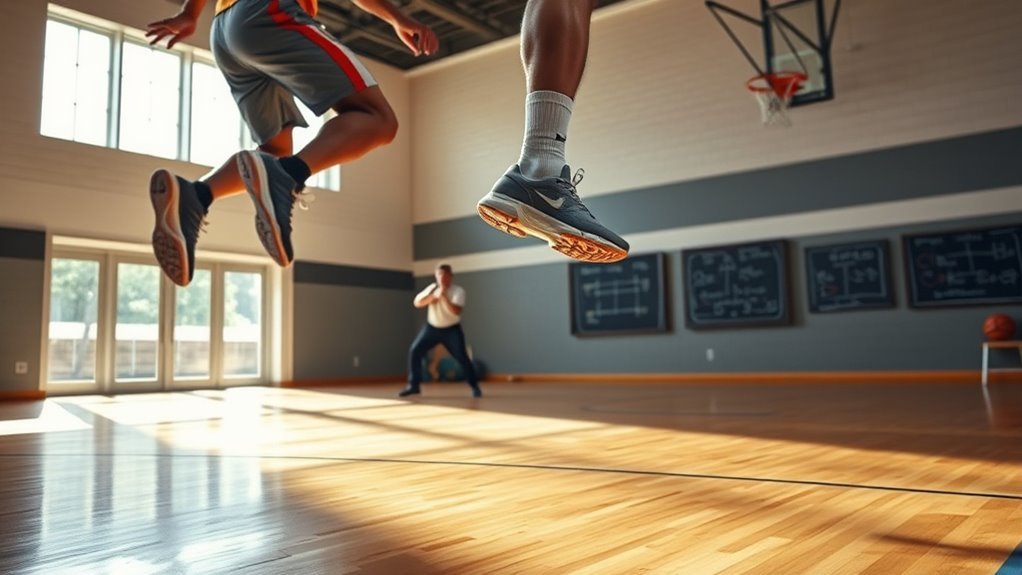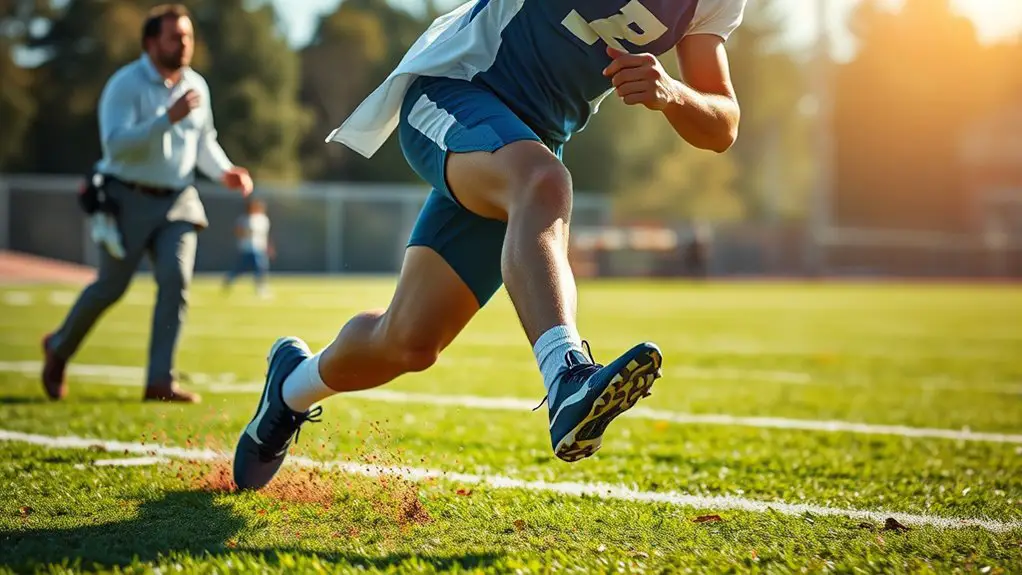To boost your vertical jump height for basketball, focus on strengthening key muscles like your quadriceps, hamstrings, glutes, and calves. Incorporating plyometric exercises, such as box jumps and tuck jumps, will train your muscles for explosive power. Don't forget to warm up properly with dynamic stretches to enhance flexibility. Also, maintain a balanced diet rich in lean proteins and complex carbohydrates, and allow time for recovery. Keep exploring to uncover more effective strategies for your jump training!
Understanding the Importance of Vertical Jump in Basketball
When you step onto the court, the ability to jump high can set you apart from the competition. It's not just about scoring; it's about seizing opportunities and making those game-changing plays. A powerful vertical jump helps you reach the basket, block shots, and grab rebounds, giving you that exhilarating freedom to dominate the game. Plus, it adds flair to your style, making every dunk feel like an expression of your passion. You'll notice how defenders struggle to keep up, allowing you to showcase your true potential. Embracing the importance of vertical jump height isn't just a technical aspect; it's a key part of your journey toward basketball excellence. So, elevate your game, and let your leaps reflect your drive for freedom on the court!
Key Muscles Involved in Jumping
A powerful jump relies on a group of key muscles working together to propel you upward. Understanding these muscles can help you train effectively and reach new heights. Your legs, core, and even your arms play critical roles in achieving that explosive leap.
| Muscle Group | Function | Importance |
|---|---|---|
| Quadriceps | Extend the knee | Provides power |
| Hamstrings | Flex the knee | Stabilizes movement |
| Glutes | Hip extension | Drives upward motion |
| Calves | Ankle flexion | Aids in push-off |
| Core Muscles | Stabilization | Supports posture |
Essential Warm-Up Exercises
Warming up is essential for maximizing your vertical jump performance, and incorporating a few important exercises can make a significant difference. A proper warm-up prepares your muscles, enhances flexibility, and gets your blood pumping. Here are three effective warm-up exercises to include in your routine:
Warming up is key to boosting your vertical jump, enhancing flexibility, and preparing your muscles for action.
- Dynamic Stretching: Focus on leg swings and arm circles to loosen up your joints and increase your range of motion.
- High Knees: This exercise elevates your heart rate and activates your hip flexors, critical for jumping.
- Butt Kicks: Running in place while kicking your heels to your glutes works your hamstrings and improves overall mobility.
Integrating these warm-up exercises into your routine will help you feel more agile and ready to soar when you hit the court.
Plyometric Training for Explosive Power
Plyometric training is essential for developing explosive power, as it focuses on high-intensity, fast-twitch muscle movements that enhance your jumping ability. By incorporating exercises like box jumps, depth jumps, and tuck jumps, you can train your muscles to generate force quickly. These movements challenge your body and push your limits, allowing for greater vertical leaps on the court.
To get the most out of your plyometric workouts, aim for 2-3 sessions a week, with adequate rest in between. It's vital to maintain proper form to avoid injury and maximize effectiveness. As you progress, increase intensity by adding weights or varying the height of jumps. Embrace the challenge, and you'll find yourself soaring higher with each jump!
Strength Training Techniques
While plyometric training builds explosive power, integrating strength training techniques is equally important for enhancing your vertical jump. By focusing on specific muscle groups, you'll develop the strength needed to propel yourself higher. Here are three effective strength training exercises to take into account:
- Squats: Engage your quads, hamstrings, and glutes by performing deep squats. This foundational move increases your overall leg strength.
- Deadlifts: This exercise targets your posterior chain, vital for generating upward force, allowing you to harness power effectively.
- Lunges: Incorporate forward and lateral lunges to improve stability and strength in all directions, enhancing your agility on the court.
Embrace these techniques, and you'll boost your vertical jump while feeling empowered on the basketball court.
Flexibility and Mobility Drills
Incorporating flexibility and mobility drills into your training routine is essential for maximizing your vertical jump. These drills enhance your range of motion, allowing your muscles to work more efficiently during explosive movements. Focus on dynamic stretches like leg swings and lunges to warm up those muscles, and incorporate static stretches like hamstring and hip flexor stretches post-workout to improve flexibility. Yoga and foam rolling can also help release tension and promote better mobility. When your body moves freely, you'll jump higher and perform better on the court. Prioritize these drills to unleash your full potential, giving you the freedom to soar above the rim and elevate your game. Embrace this journey to elevate your vertical leap!
Nutrition and Recovery for Optimal Performance
To achieve ideal performance in your vertical jump, it's crucial to focus on nutrition and recovery. What you fuel your body with can make all the difference. Here are three key components to enhance your performance:
Focusing on nutrition and recovery is essential for optimizing your vertical jump performance.
- Lean Proteins: Think grilled chicken or quinoa; these help repair muscles and build strength.
- Complex Carbohydrates: Imagine hearty oats or sweet potatoes; they provide lasting energy for your jumps.
- Hydration: Visualize a revitalizing glass of water; staying hydrated keeps your muscles functioning at their best.
Don't overlook recovery, either. Incorporate rest days and practices like foam rolling or stretching to let your body heal and grow. Prioritize these elements, and you'll feel the freedom of soaring higher with each jump!
Tracking Your Progress and Setting Goals
Tracking your progress and setting goals is essential for improving your vertical jump. By keeping a journal or using an app, you can monitor your jump height, workout routines, and recovery times. This data helps you identify what's working and what needs adjustment. Set realistic, measurable goals—like increasing your jump by an inch each month. Celebrate small victories; they keep you motivated and focused. Remember, the journey to freedom in your game is as important as the destination. Regularly reassess your goals based on your progress and stay adaptable. By doing this, you'll not only enhance your vertical jump but also cultivate a mindset geared towards continuous improvement. Embrace the process, and watch your game elevate!
Frequently Asked Questions
How Long Does It Take to See Improvement in Vertical Jump Height?
You might feel like a caged bird, yearning to soar. Typically, you'll see improvements in your vertical jump within 4 to 8 weeks of consistent training, but results can vary based on your dedication and effort.
Can Jumping Higher Reduce the Risk of Injury in Basketball?
Jumping higher can indeed reduce injury risk, as it improves your ability to land safely and absorb impact. By enhancing your vertical jump, you're not just elevating your game but also protecting your body.
Are There Specific Shoes That Enhance Vertical Jump Performance?
You know, just like a superhero needs their suit, specific shoes can boost your vertical jump. Look for lightweight, cushioned options with good traction. They'll help you feel more agile and confident on the court!
Is It Beneficial to Practice Jumping on Different Surfaces?
Practicing jumping on different surfaces can definitely help you adapt and strengthen your muscles. It challenges your body in unique ways, improving balance and stability, which might just give you that extra edge you're looking for.
How Does Body Weight Affect My Vertical Jump Potential?
Your body weight can influence your vertical jump potential. If you're carrying excess weight, it might hinder your leap. However, lean muscle can enhance your power, allowing for greater height when you jump.




